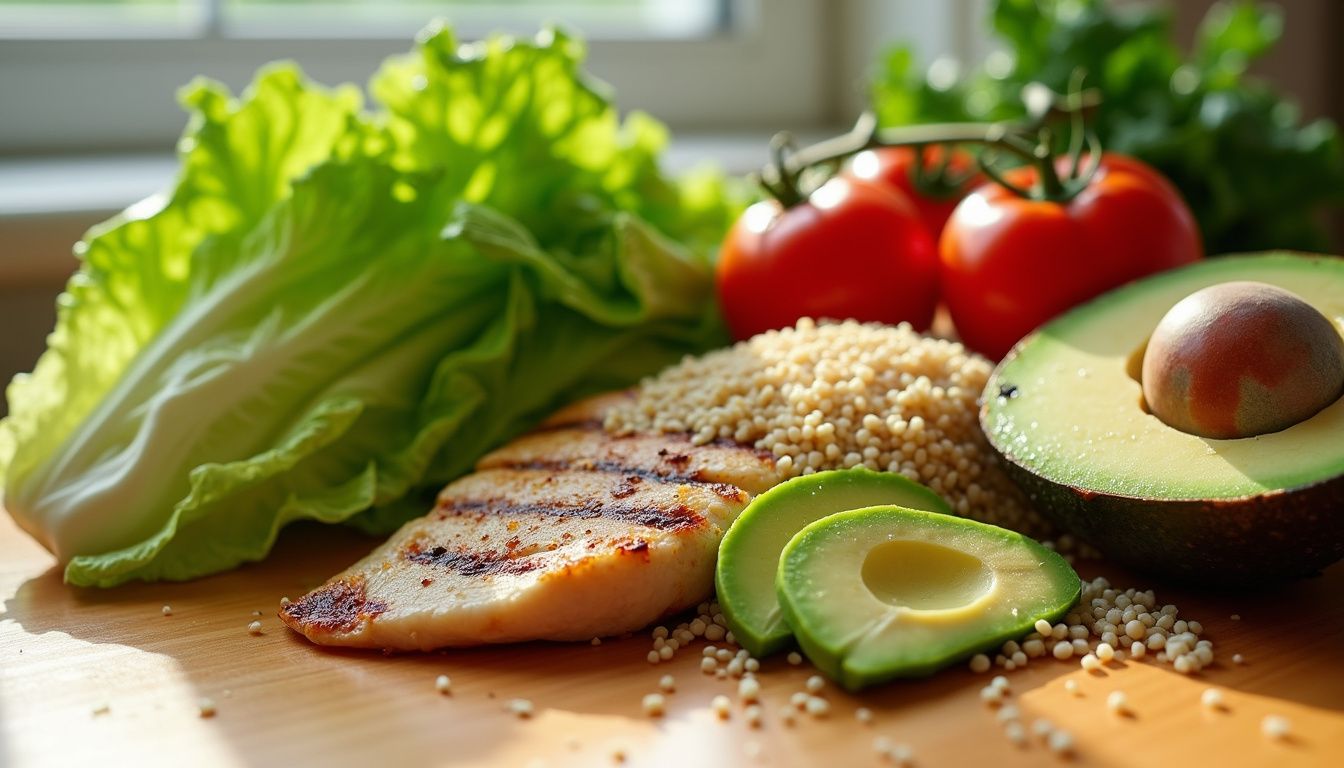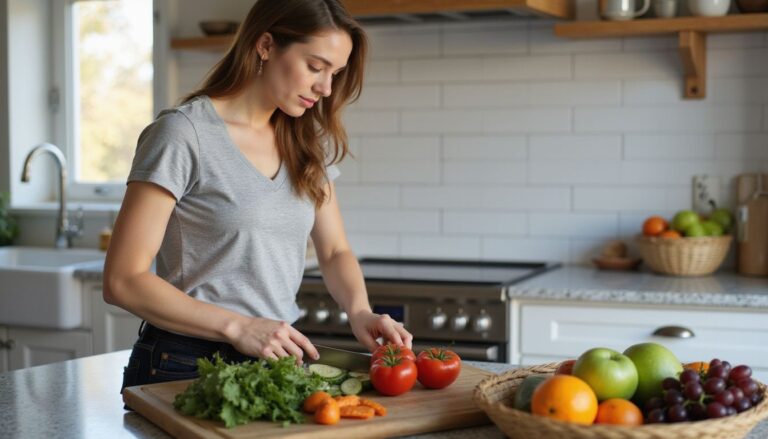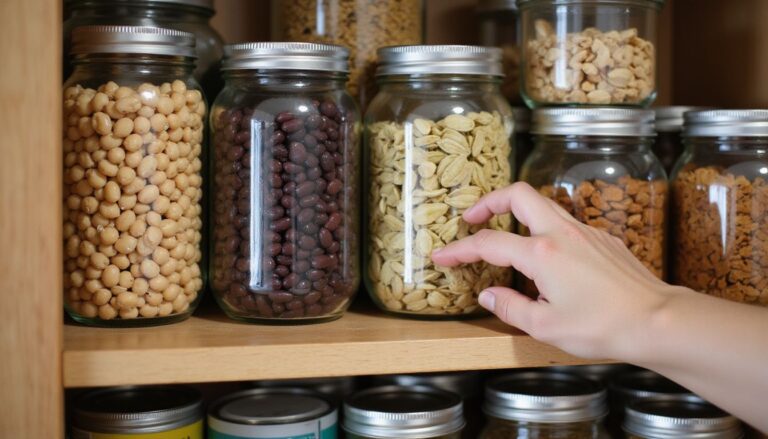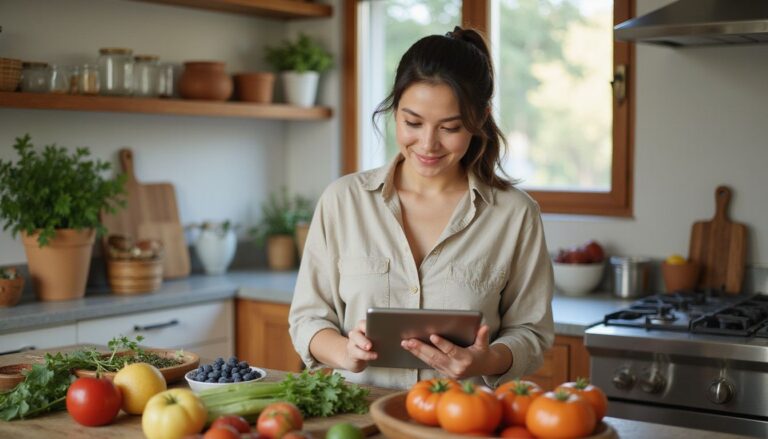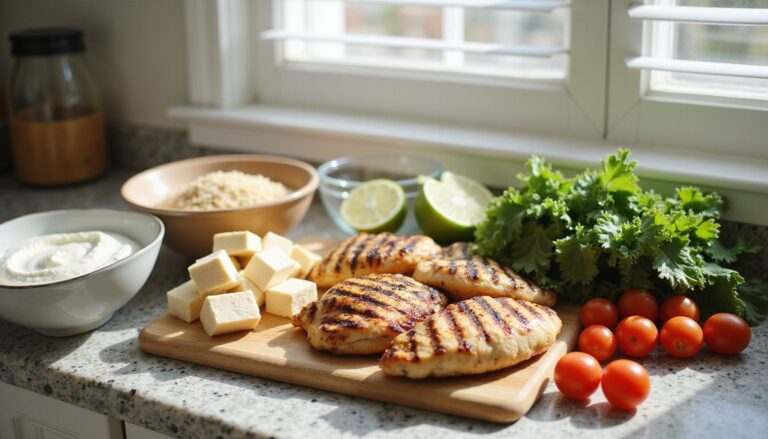Delicious Low Calorie Lunch Ideas For Healthy Meals
Our Nutrition Assistant AI Suite will transform your body. You will lose fat, get toned, and build muscle. Gain confidence and optimal health.
Getting bored with the same lunch or struggling to find a healthy meal that keeps you full is common. A low-calorie lunch can fix both. Many lunch recipes combine protein and fiber for steady energy, often staying under 575 calories per serving.
This guide shares fast, tasty ideas packed with vegetables, lean protein, and whole grains. Most are simple to prep in minutes. Pick one today and find a new favorite.
Key Takeaways
- Choosing low-calorie lunches, such as meals under 400 calories, supports weight loss and steady energy during the day (Journal of Nutrition, 2023).
- Meals that pair lean proteins like chicken or tuna with fiber-rich vegetables and whole grains increase fullness without topping 575 calories per serving.
- Portion control strategies, such as using pre-portioned containers and measuring servings, reduce overeating and make meal prep easier.
- Swapping dense foods for lettuce wraps, spiralized zucchini noodles, or veggie-heavy salads cuts calories while boosting vitamins A and C and dietary fiber.
- Adding healthy fats from avocado or olive oil supports fullness and brain health without adding excess sugar or calories.
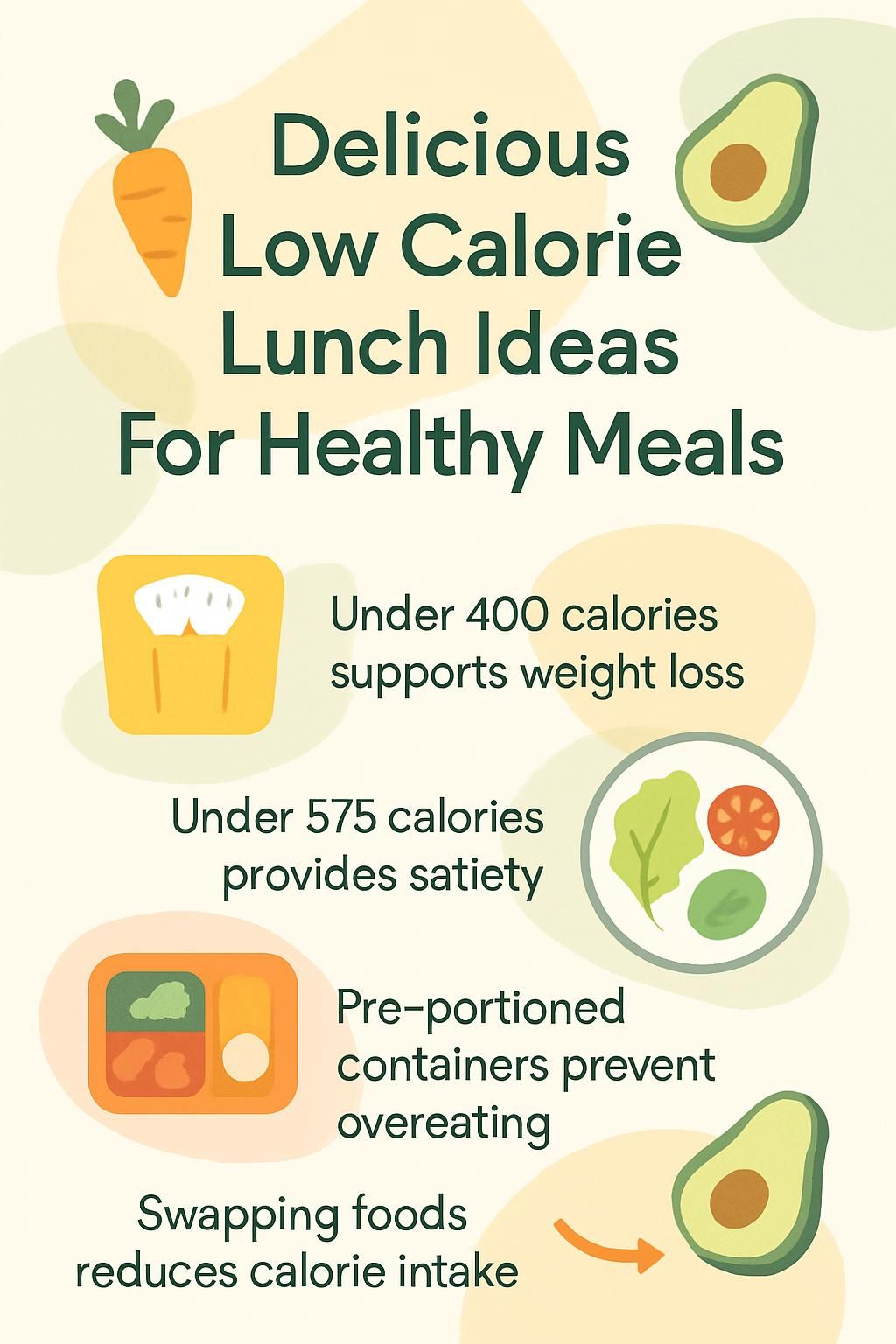
Why Are Low-Calorie Lunches Good for You?

Low-calorie lunches let you enjoy a satisfying lunch idea without extra calories. With the right mix of nutrients, your lunch or dinner feels light and still nourishing.
How Do Low-Calorie Lunches Support Weight Management?
Reducing lunch calories helps lower your total daily intake, which supports weight loss and maintenance. Meals around 400 calories, like a veggie wrap or chicken salad lettuce wrap, help maintain a calorie deficit while keeping flavor high.
Simple swaps make a big difference. Use spiralized zucchini instead of regular pasta or lettuce leaves instead of bread to lower calories while keeping the meal satisfying.
A 2023 study in the Journal of Nutrition found that people who ate lunches under 400 calories lost more weight over 12 weeks compared to those who did not track lunch calories.
Meal prep recipes, such as chickpea salad or BLT pasta salad, make portion control easier. Weekly grocery lists and structured plans, like 1,200 or 1,400 calorie guides, add routine that prevents overeating.
Building a habit of nutrient-dense, low-calorie lunches helps you stay on track without feeling deprived.
How Can Low-Calorie Lunches Help Maintain Energy Levels?
Beyond weight goals, a smart lunch also stabilizes energy. Pair lean protein like chicken breast, eggs, or salmon with fiber-rich vegetables such as broccoli and kale to get steady fuel without heavy calories.
Fiber from foods like lentil soup or a vegan salad slows digestion, so glucose enters your blood more slowly. That means fewer energy dips later.
Registered dietitian Stefani Sassos, M.S., R.D.N., C.D.N., NASM-CPT, suggests adding healthy fats. Try avocado slices on a lettuce sandwich or a light olive oil vinaigrette. These fats support fullness and mental focus after lunch.
Whole grains, such as couscous or a power salad in a mason jar, offer complex carbs and protein for longer-lasting satisfaction. Instead of a heavy pasta dish, choose hummus with mixed greens or chickpea salad for a light but filling meal.
Many low-calorie lunches land under 400 calories and still taste great. That balance makes it easier to power through to dinner.
Why Choose Nutrient-Rich Foods for Lunch?
Your body needs more than calories. Nutrient-rich choices like lentils, chickpeas, and colorful vegetables deliver vitamins, minerals, and fiber that support health.
Lean proteins, including chicken, turkey, tofu, and seafood, help control hunger while keeping calories lower. High-fiber foods also support digestion and can help lower cholesterol.
Mixed greens or salad lettuce wraps provide antioxidants that protect cells. Whole grains such as brown rice or quinoa add B vitamins that help your body convert food into energy.
Choosing nutrient-dense options gives you big flavor without extra calories. For example, a black bean salad provides hearty texture and protein with less saturated fat than a fried entrée.
Tips for Preparing Low-Calorie Lunches
Preparing delicious low-calorie lunches helps you cut extra calories and added sugar while still enjoying bold flavor. Focus on wholesome ingredients and simple lunchbox ideas that fit your schedule.
Why Focus on Lean Proteins and Fresh Vegetables?
Lean proteins like rotisserie chicken, tuna, shrimp, turkey, and chickpeas deliver energy and fullness with fewer calories. Protein supports muscle health and appetite control.
Evidence shows protein-rich meals reduce hunger and support weight goals. For example, a 4-ounce grilled chicken breast has about 170 calories and more than 30 grams of protein.
Fresh vegetables such as Roma tomatoes, kale, spinach, zucchini, carrots, bell peppers, and cucumbers add crunch and nutrients for very few calories. Colorful produce brings fiber and vitamins that help you stay satisfied longer.
Swap bread for lettuce or pickle wraps to reduce carbs and boost produce. Meals built on lean protein and vegetables provide balance for busy days.
How to Incorporate Whole Grains and Healthy Fats?
Whole grains and healthy fats make lunches more filling without adding many calories. They support steady energy and heart health.
- Add quinoa or whole-wheat pasta to salads like quinoa chickpea salad or lemon chicken pasta for fiber and lasting energy.
- Choose whole-wheat pita, bread, or tortillas for wraps and sandwiches, as in a whole-wheat veggie wrap. Complex carbs help you stay full.
- Use avocado slices in meals such as spicy bean and avocado quesadillas, or top mixed greens with lentils and apple for creamy texture and healthy fats.
- Drizzle olive oil on salads like chopped cobb salad or roasted shrimp, tomatoes, and spinach salad. Monounsaturated fat supports heart health.
- Include hummus in sandwiches, bowls, or as a dip. It adds protein and unsaturated fat that slow digestion and manage hunger.
- Sprinkle feta on lunch bowls like fig and goat cheese salad for flavor and calcium while keeping portions light.
- Add nuts or seeds, such as walnuts or sunflower seeds, to power salads with chickpeas and tuna for crunch and omega-3s.
- Cook quick one-pot recipes using couscous and chickpea salad or orzo and chickpea soup. These grains cook fast and deliver nutrients per serving.
What Are Effective Portion Control Strategies?
Measuring portions reduces calories and curbs overeating at lunch. A few simple habits make prep smoother, especially if you pack single servings.
- Use pre-portioned containers like mason jars for salads such as a chopped Cobb salad or BLT pasta salad to keep portions under 575 calories.
- Fill half your plate or lunchbox with fresh vegetables, like leafy greens, chopped tomatoes, or roasted red pepper, to add volume and nutrients.
- Measure proteins like cooked chicken, eggs, or shrimp with a food scale. Most recipes suggest 3 to 4 ounces per serving for a balanced plate.
- Include high-fiber grains, like quinoa or spaghetti squash. Stick to 1/2 cup cooked in easy pasta salad options to manage carbs and calories.
- Limit fats by measuring dressings or hummus. Two tablespoons of Greek yogurt sauce or roasted red pepper hummus is often enough.
- Choose single-serve fruit packs, like orange slices or apple wedges, to hit sweet cravings while managing calories during the week.
- Avoid eating from large bags or family-size packages. Portion nuts, black beans, or crackers into small bowls to track intake.
- Read serving sizes on recipes. For example, BLT pasta salad may be portioned for kids ages 9 to 12 with two veggie servings, so adjust portions during prep.
Quick and Easy Low-Calorie Lunch Ideas
These quick low-calorie lunch ideas pack bright flavor and simple steps. Most can be made in minutes and travel well.
What Is a Healthy Veggie & Hummus Sandwich Recipe?
This veggie and hummus sandwich delivers protein, fiber, and crunch in under 10 minutes. It is a vegetarian classic that holds up in a lunchbox.
- Use two slices of whole grain bread for more fiber than white bread.
- Spread 2 tablespoons of hummus on each slice. Roasted red pepper or classic chickpea both work well.
- Layer sliced cucumbers, tomatoes, bell peppers, and pickled cucumber for crisp texture.
- Add greens like spinach or arugula for vitamins A and C.
- Include thinly sliced onion and a pinch of black pepper for zing.
- Sprinkle chopped herbs such as basil or parsley for a fresh finish.
- Drizzle a touch of balsamic vinegar or mustard dressing for brightness with few calories.
- Pair with orange slices or apple wedges for vitamin C and natural sweetness.
- Pack it for school or work. It stays fresh in the fridge for several hours.
Rotate hummus flavors or swap in seasonal vegetables next time. Then try egg salad lettuce wraps for a low-calorie change of pace.
How to Make Egg Salad Lettuce Wraps?
Egg salad lettuce wraps taste fresh and come together in under 10 minutes. Using iceberg lettuce instead of bread keeps carbs and calories low.
- Boil four large eggs for about 9 minutes. Cool under cold water and peel.
- Chop the eggs. Mix with two tablespoons Greek yogurt or light mayo, one teaspoon mustard, a pinch of salt, pepper, and chopped celery for crunch.
- Lay out whole iceberg leaves as the wrap base. Their crispness holds filling and lowers calories compared with bread.
- Spoon two tablespoons egg salad onto each leaf. Add diced tomatoes or shredded carrots for color and nutrients.
- Sprinkle paprika or chili flakes for gentle heat without added calories.
- Roll up each leaf to form a hand-held wrap or pack in your lunchbox.
- Eat right away for crunch, or store wrapped in parchment for up to one day.
- Iceberg is over 94 percent water by weight, so it adds hydration while cutting carbs.
- Using lettuce creates a gluten-free option that fits vegetarian and high-protein plans when paired with tomato soup or roasted sweet potato wedges.
On busy workdays, I love this recipe. Chop, mix, roll, and eat in minutes.
What Are the Ingredients for Lemon Chicken Pasta?
After those wraps, a warm, bright lunch feels great. Lemon chicken pasta brings zesty flavor with a healthy balance of protein and vegetables.
- Use 1 cup diced rotisserie chicken for quick prep and lean protein.
- Add spiralized zucchini for a low-calorie, high-fiber boost. It mimics noodles while keeping carbs down.
- Cook whole-wheat pasta if you want extra fiber. About 2 ounces per serving is enough.
- Add 1 tablespoon fresh lemon zest and juice for tang that pairs well with chicken.
- Top with about 1 tablespoon toasted breadcrumbs per bowl for crunch without heavy sides like fries or garlic bread.
- Toss in a handful of cherry tomatoes for color and antioxidants.
- Drizzle 1 teaspoon olive oil for healthy fats that support steady energy.
- Fold in chopped parsley or a handful of spinach if you prefer extra greens.
- Season with salt, black pepper, and a pinch of mustard powder to lift the flavors.
- Mix in one skillet. It takes under 30 minutes and fits an easy low-calorie lunch plan.
I often make this with leftover roast chicken. Lemon zest and crunchy crumbs taste rich without heavy butter sauces.
How to Prepare Mixed Greens with Lentils & Sliced Apple?
This salad is high in protein and easy to pack. Using canned lentils speeds things up and makes meal prep simple.
- Rinse one can of low-sodium lentils under cold water to remove extra salt.
- Add 2 cups mixed greens to a bowl as a nutrient-rich base.
- Slice half a crisp apple into thin wedges for sweetness and extra fiber.
- Layer the lentils and apple over the greens for balanced texture.
- Sprinkle chopped walnuts or roasted seeds for crunch and healthy fats.
- Drizzle 1 to 2 tablespoons lemon juice or balsamic vinegar as a light dressing.
- Toss gently so each bite includes greens, apple, lentils, and a bit of acid.
- Pack in a lunch container or serve right away. It stays fresh for up to two days.
This salad fits neatly into my lunch container and travels well. Rinsed canned beans make prep fast without cooking.
What Is Quinoa Chickpea Salad with Roasted Red Pepper Hummus Dressing?
This hearty vegan salad is rich in plant protein and fiber. The hummus dressing adds bold taste with modest calories.
- Quinoa provides complete plant protein and key minerals like magnesium.
- Chickpeas add more protein and fiber. One cup cooked gives about 15 grams of protein and 13 grams of fiber.
- Roasted red pepper hummus works as a flavorful, lower-calorie dressing with healthy fats from tahini and olive oil.
- Bell peppers, cucumbers, cherry tomatoes, and leafy greens boost vitamin C and add crunch.
- Each serving averages about 350 calories with under 8 grams of fat, and it fits vegan and gluten-free diets.
- Meal prep it in advance, then pack for quick weekday lunches.
- High fiber supports fullness. Bean-rich diets are linked with better appetite control.
- Mediterranean flavors also pair well with grilled halloumi or chicken caprese if you want variety.
- Hummus dressing can use a splash of pickling brine for tang, which reduces added salt.
- Make-ahead salads like this save time while keeping lunch healthy and satisfying.
Low-Calorie Salads for a Healthy Lunch
Low-calorie salads can be hearty and bright. Combine lean protein, fresh vegetables, and lighter dressings for a crisp lunch that travels well.
What Makes a Chopped Cobb Salad Low-Calorie?
A chopped Cobb salad can be light, flavorful, and filling. Small swaps keep calories in check without losing the classic feel.
- Use grilled healthy chicken for protein instead of bacon to lower saturated fat and calories.
- Add a hard-boiled egg for extra protein and fullness at roughly 70 calories.
- Choose spinach or romaine for fiber, vitamins, and minerals. They add volume with fewer calories.
- Mix in tomatoes for color and vitamin C.
- Include cucumbers, peppers, or shredded carrots to add volume without many calories.
- Keep dressing on the side and pick vinaigrettes or lemon-based sauces instead of creamy options like sour cream.
- Measure ingredients so each serving stays balanced and low-calorie.
- Avoid large amounts of cheese or fried toppings that raise calories fast.
- Try single-serve portions to track intake more easily.
- Balance protein and vegetables for lasting energy through the afternoon.
With lean meat, fresh produce, portion awareness, and lighter dressings, a Cobb salad becomes a satisfying, calorie-conscious meal.
How to Prepare a Fig & Goat Cheese Salad?
Fresh figs and creamy goat cheese make this salad feel gourmet, yet it takes minutes to build. It fits both a work lunch and a weekend meal.
- Slice 3 to 4 fresh figs or sub in dried apricots if figs are out of season. Both offer fiber and potassium.
- Toss 2 cups mixed greens, such as spinach, arugula, or lettuce, with the fruit for texture and color.
- Crumble 2 ounces goat cheese for protein, calcium, and tangy flavor.
- Add a handful of walnuts or pecans for crunch and healthy fats. Use sparingly to keep calories in check.
- Dress with 1 to 2 tablespoons balsamic vinegar and 1 tablespoon extra virgin olive oil for a simple lower-sodium option.
- Sprinkle black pepper or a pinch of chili flakes for subtle heat.
- Serve with whole grain toast or pair with grilled chicken for more staying power.
- Eat right away for crisp greens, or pack in a mason jar for up to 48 hours.
- A sliced orange on the side adds brightness and vitamin C.
- Each serving typically stays under 300 calories based on recent USDA data.
What Are the Ingredients in a Mason Jar Power Salad with Chickpeas & Tuna?
Try this protein-packed power salad next. Each serving delivers about 26 grams of protein and 8 grams of fiber, which makes it a strong meal prep option.
- Add rinsed chickpeas as the base for plant protein and fiber.
- Top with canned tuna in water to boost lean protein and fullness.
- Layer chopped kale for vitamins A, C, and K plus extra fiber.
- Include diced cucumber for crunch and hydration with very few calories.
- Scatter grape tomatoes for lycopene and color.
- Sprinkle shredded carrots to increase vitamin A for eye health.
- Pour in a dressing of olive oil, lemon juice, Dijon mustard, salt, and pepper to tenderize the kale.
- Finish with sliced red onion or bell peppers for zip and more vitamins.
Stacking ingredients in a mason jar keeps greens crisp all week. You get protein, healthy fats, fiber, and vitamins for less per serving than most takeout salads.
How to Make a Fresh Salmon Niçoise Salad?
A fresh Salmon Niçoise Salad is a classic French dish that delivers protein and color. It comes together in about 38 minutes.
- Grill or pan-sear salmon for omega-3s. Cool slightly, then flake into large pieces.
- Boil baby potatoes for 10 minutes. Halve and set aside with blanched green beans for crisp texture.
- Arrange mixed greens on your plate. Add halved grape tomatoes, sliced cucumbers, olives, and red onion.
- Add green beans, potatoes, and salmon for balance and fiber.
- Slice hard-boiled eggs and place beside the other toppings.
- Make a light vinaigrette with Dijon, olive oil, lemon juice, salt, and pepper. Drizzle just before serving.
- Garnish with parsley or dill. Serve chilled or at room temperature.
- Enjoy as a standalone lunch or with soup or whole grain bread.
- This salad delivers protein from salmon and eggs with plenty of vegetables, often with fewer calories than heavy sandwiches.
What Is a Roasted Shrimp, Tomatoes, and Spinach Salad?
Roasted shrimp, tomatoes, and spinach make a quick salad with very little cleanup. Everything cooks on one sheet pan.
- Use fresh spinach as the base for fiber and iron.
- Roast onions, cherry tomatoes, and peeled shrimp at 400°F for 10 to 12 minutes to keep calories low while building flavor.
- Each serving typically lands under 200 calories, which fits weight management plans.
- Toss the warm shrimp and vegetables with the spinach. Add basil or parsley if you like.
- Serve right away with a squeeze of lemon for vitamin C and brightness.
- This recipe offers lean protein, antioxidants, and a prep time under 20 minutes.
- Season with barbecue spice or a pinch of chili for variation without extra fat.
- Store leftovers in an airtight container for up to two days.
- Cooking everything at once saves time and keeps dishes to a minimum.
Low-Calorie Wraps and Sandwiches
Low-calorie wraps and sandwiches use simple ingredients like lettuce, tortillas, and lean protein to build satisfying meals without extra calories.
How to Make Pickle Sub Sandwiches with Turkey & Cheddar?
Pickle sub sandwiches are crunchy and low-carb. Replacing bread with thick pickle slices keeps calories down and flavors bright.
- Slice large dill pickles lengthwise to form bun-shaped halves.
- Pat the slices dry so the sandwich holds together.
- Layer about 2 ounces of fresh turkey breast on one pickle half for lean protein.
- Add a thin slice of cheddar, about 0.5 ounces, for flavor with modest calories.
- Place Roma tomato slices on top for color and vitamins A and C.
- Season with ground black pepper or paprika for extra taste.
- Top with the second pickle slice and serve right away for crunch.
- This no-bread option comes together in minutes.
- Each sandwich usually ranges from 120 to 150 calories based on 2023 USDA data.
What Is a Whole-Wheat Veggie Wrap?
After a pickle sub, try a fiber-rich wrap with plenty of vegetables. Whole-wheat wraps support digestive health and keep you full.
- Start with a whole-wheat wrap for more fiber than white flour wraps.
- Layer leafy greens like spinach or romaine to add vitamin K and folate.
- Add roasted zucchini or squash for extra antioxidants.
- Stack colorful vegetables, such as shredded carrots, bell peppers, and cucumbers, for crunch and nutrients.
- Spread hummus or mashed avocado to add healthy fats and help the wrap hold together.
- Include lean proteins like grilled tofu, tempeh, or sliced boiled egg to boost satiety.
- Sprinkle seeds or nuts for texture and a little extra protein.
- Roll tightly for easy portability, perfect for school or work.
- Switch up spreads and fillings through the week to keep lunches interesting.
- On Sunday, I prep several wraps with different fillings. It saves time and keeps meals balanced.
How to Prepare Chicken Lettuce Wraps?
Chicken lettuce wraps offer a tasty, low-calorie lunch. Butter lettuce makes a crisp shell that holds a flavorful filling.
- Select firm butter lettuce leaves to use as wraps.
- Dice cooked chicken breast into small pieces for a lean protein base.
- Sauté hoisin-coated mushrooms in a nonstick pan. Add chopped water chestnuts for crunch with little fat.
- Combine chicken, mushrooms, and water chestnuts until evenly coated for big flavor with modest calories.
- Spoon about 1/4 cup of filling into each lettuce leaf to control portions.
- Top with sliced green onions or cilantro for freshness.
- Add a small drizzle of teriyaki if desired, and keep it light to control sodium.
I often pack these for work. They stay fresh and help me manage calories without feeling hungry.
What Are the Ingredients for BLT Pasta Salad?
BLT pasta salad is fast to prepare and kid friendly. Using whole-grain pasta adds fiber and helps you feel full.
- Use 2 cups cooked whole-grain pasta for complex carbs and fiber.
- Add 1 cup chopped tomatoes for vitamin C and lycopene.
- Mix in 1 1/2 cups shredded romaine or mixed greens for extra vegetables.
- Include 3/4 cup cooked bacon pieces or diced grilled chicken breast for protein with fewer calories than steak fajita wraps.
- Toss with 1/4 cup light mayo or Greek yogurt to add creaminess with less fat.
- Season with black pepper and a pinch of salt instead of heavy dressings.
- Top with sliced avocado or chopped red onion for flavor and more nutrients.
Try other salads next if you want more light, tasty, and filling options.
Vegetarian and Vegan Low-Calorie Lunch Options
Plant-based lunches can be low in calories and high in nutrients. Vegetables, wraps, and legumes bring color, flavor, and balance to your plate.
How to Make Meal-Prep Vegan Lettuce Wraps?
Vegan lettuce wraps are crisp, fiber rich, and easy to make ahead. They use lettuce as the wrap and a hearty grain and bean filling.
- Wash and dry large romaine or butter lettuce leaves.
- Cook one cup of quinoa and cool it.
- Combine quinoa with black beans, corn, diced tomatoes, and chopped cilantro.
- Add one can of rinsed chickpeas for more protein and fiber.
- Season with lime juice, salt, pepper, cumin, and a pinch of chili powder.
- Spoon two to three tablespoons of filling onto each leaf, then fold like a classic wrap.
- Pack in meal prep containers lined with paper towels to reduce moisture.
- Make enough for several lunches. They keep up to three days in the fridge.
- Serve plain or with roasted red pepper hummus for dipping.
Explore more vegetarian and vegan low-calorie lunch recipes below.
What Is Sweet Potato & Lentil Soup?
Sweet potato and lentil soup is cozy, filling, and vegetarian. It is high in fiber and comes together in about 35 minutes.
- Use peeled sweet potatoes, rinsed lentils, diced onions, garlic, and carrots for flavor and nutrition.
- Simmer in vegetable broth for about 25 minutes until tender.
- Season with ground cumin, black pepper, and salt for warmth without many calories.
- Blend half the soup for a creamy yet chunky texture that feels hearty.
- Each serving stays under 300 calories and provides protein and fiber from lentils.
- Sweet potatoes add vitamin A and potassium for immune and muscle support.
- This vegan-friendly lunch keeps you full until dinner.
- More than 300 reviewers rate it highly for taste and satisfaction.
- Make extra portions for the week. Store in airtight containers for quick lunches.
- Serve with whole-grain toast or enjoy it on its own as a gluten-free meal.
- I cook this weekly. It fits my schedule and keeps me full every time.
Key facts: High fiber, 35-minute prep, lentils and sweet potatoes for balance, strong user ratings, rich flavor with low calories.
How to Prepare Spicy Bean & Avocado Quesadillas?
Spicy bean and avocado quesadillas offer bold flavor in about 20 minutes. They help you reach several daily vegetable servings with modest calories.
- Gather whole-wheat tortillas, canned black beans, chopped bell peppers, diced red onion, sliced avocado, and shredded low-fat cheese.
- Rinse and mash one cup black beans with 1/2 teaspoon chili powder.
- Heat a nonstick skillet over medium and mist with olive oil spray.
- Spread mashed beans over half each tortilla. Layer bell peppers, onion, and avocado.
- Sprinkle two tablespoons low-fat cheese to add calcium with less fat.
- Fold and press gently. Cook 2 to 3 minutes per side until crisp and golden.
- Cut into wedges. Serve hot with salsa or plain Greek yogurt instead of sour cream.
- Expect about 300 calories per serving with strong taste ratings.
Keep reading for more vegetarian and vegan low-calorie lunch ideas that stay exciting and satisfying.
What Are Tomato Soup & Hummus Crispbreads?
Tomato soup with hummus crispbreads makes a light vegan lunch that still fills you up. It is simple to assemble and comforting on cool days.
- You simmer a tomato-heavy soup loaded with vegetables for fiber and nutrients.
- Pair it with hummus spread on whole grain or seed crackers for protein and crunch.
- Each serving fits under 400 calories, which supports weight goals.
- High user ratings reflect great taste and texture.
- All ingredients are plant-based, so it fits vegan diets.
- Total time is about 50 minutes, including soup simmering and assembly.
- This combo keeps you full through the afternoon thanks to fiber and water-rich foods.
Next, explore more low-calorie salads to widen your lunch rotation.
Protein-Packed Low-Calorie Lunches
Protein-packed low-calorie lunches increase fullness and support muscle health. These options use simple ingredients to keep calories in check.
How to Make Teriyaki Tofu?
Teriyaki tofu is a fast, vegetarian-friendly lunch with plenty of protein. It takes around 30 minutes and works well for batch cooking.
- Press a block of firm tofu for at least 10 minutes to remove extra water.
- Cut tofu into bite-size cubes for even cooking and better flavor absorption.
- Marinate in low-sodium soy sauce, ginger, garlic, and a little honey for 15 minutes.
- Heat a nonstick skillet over medium. Add a teaspoon of oil, then cook tofu until golden on all sides.
- Steam broccoli florets during the last five minutes for vitamins and fiber.
- Serve with brown rice or whole grain noodles for more nutrients than white rice.
- Garnish with sesame seeds or sliced green onions and serve hot.
- Many cooks give this recipe strong ratings on trusted food sites.
- I often make a double batch on Sunday so lunches are set for days.
- Each serving offers high protein for a vegetarian meal.
This method creates a flavorful lunch that fits healthy meal plans and keeps energy steady through the afternoon.
What Is Shrimp Gazpacho?
Shrimp gazpacho blends chilled tomato soup with lean shrimp for a light, protein-rich lunch. It is perfect for warm days and requires little cooking.
- Use ripe tomatoes as the base for vitamins A and C with few calories.
- Add cucumbers, red onion, and bell peppers for fiber, crunch, and more nutrients.
- Mix in cooked shrimp. A 3-ounce portion provides about 18 grams of protein with fewer than 90 calories.
- Blend a small amount of olive oil into the soup for healthy fats.
- Season with lemon juice, garlic, salt, and pepper for depth without added sugar.
- Chill for at least two hours to let flavors meld.
- Top with fresh herbs like parsley or cilantro for antioxidants.
- It holds well in the fridge and makes a fast weekday lunch.
See the next section for another protein-forward idea with fresh flavors.
How to Prepare Chicken Banh Mi Smash Tacos?
Fusion lunches can be fun and light. Chicken banh mi smash tacos mix lean protein with crisp vegetables in a crunchy shell.
- Choose ground chicken breast for a lower-calorie protein. A 3-ounce portion has about 130 calories and over 20 grams of protein.
- Sauté the chicken on medium-high with a quick olive oil spray. Season with ginger, garlic powder, soy sauce, and a pinch of pepper.
- Make quick pickled vegetables by tossing thinly sliced carrots, radishes, and cucumbers with rice vinegar, a teaspoon of sugar, and a pinch of salt. Rest 10 minutes for crunch.
- Warm small corn tortillas until crisp. Each has around 60 calories, so watch portions.
- Layer chicken into each tortilla and pile on the pickled vegetables for vitamins A and C.
- Top with light sriracha mayo or Greek yogurt mixed with chili sauce for a lower-calorie finish.
- Garnish with cilantro or thin jalapeño slices for flavor without extra fat.
- Serve hot or at room temperature. These tacos also hold up as make-ahead lunches.
I enjoy this recipe after a long day. It is easy to cook and delivers bold, balanced flavors.
What Are the Steps for Seared Salmon with Charred Green Beans?
Seared salmon with charred green beans is fast and nutrient dense. Salmon brings protein and omega-3s, and beans add fiber and crunch.
- Wash and trim 1 cup fresh green beans per serving. Dry well for better charring.
- Season two 4-ounce salmon fillets with salt, pepper, and a pinch of red chili flakes.
- Heat a nonstick skillet over medium-high. Add green beans and cook 3 to 5 minutes, turning until blistered.
- Push beans to the side. Place salmon skin-side down and sear 3 minutes without moving.
- Flip carefully. Add 2 minced garlic cloves and 1 tablespoon drained capers beside the fish. Sauté briefly.
- Cook 2 to 3 more minutes until salmon is firm and opaque at the thickest point. The USDA recommends fish reach 145°F internally.
- Plate the salmon over beans. Spoon pan juices with garlic and capers on top. Add fresh chili if you like heat.
^1 U.S. Department of Agriculture (USDA): “Safe Minimum Internal Temperature Chart.
Creative Low-Calorie Lunch Bowls
Lunch bowls are flexible and colorful, like a painter’s palette for healthy meals. Mix bases, proteins, and veggies to keep every bowl fresh and fun.
What Is Thai Shrimp Soup?
Thai Shrimp Soup is light, fast, and fits well in a low-calorie plan. Bold spices, fresh vegetables, and lean shrimp turn each bowl into a bright meal.
- Use shrimp as the main protein to keep calories lower while getting plenty of protein.
- Flavor with lemongrass, lime juice, chili, and cilantro for a classic Thai profile.
- Add vegetables like bok choy, mushrooms, and bell peppers for fiber with few calories.
- One serving often runs 220 to 250 calories with 18 to 22 grams of protein.
- Total prep can be about 20 minutes, especially if using pre-cooked shrimp.
- Use little oil or coconut milk so fat stays modest while flavor stays rich.
- The mix of protein and water-rich vegetables supports fullness.
- Global flavors keep lunch interesting during busy weeks.
- I rely on this soup during hectic seasons. It is energizing and easy to prep ahead.
This soup is a smart pick for quick, healthy meals that deliver both taste and nutrition.
How to Make a Ponzu Tofu Poke Bowl?
A Ponzu Tofu Poke Bowl uses silken tofu and crisp vegetables with citrusy ponzu for a light lunch. It is inspired by Japanese hiyayakko and takes about 20 minutes.
- Cut one block of silken tofu into cubes. Handle gently so pieces stay intact.
- Place tofu in a shallow bowl with room for toppings.
- Add chopped cucumbers, bell peppers, and shredded carrots for crunch and color.
- Pour two tablespoons ponzu over tofu and vegetables for bright flavor with few calories.
- Top with sliced scallions and toasted sesame seeds for texture.
- Add shelled edamame or chickpeas to increase protein and fullness.
- Serve chilled. Let the bowl rest five minutes for flavors to blend.
I prepped this using fresh market produce. Lunches were fast, tasty, and easy to clean up all week.
What Is a Speedy Miso Rice Bowl?
A speedy miso rice bowl gives you umami flavor with simple steps. Pair rice with vegetables and a protein for a complete meal.
- Cook white or brown rice using a microwave pouch or quick cooker.
- Stir in one tablespoon miso paste per cup of cooked rice for savory depth.
- Add vegetables like shredded carrots, sliced bell peppers, edamame, and broccoli for fiber and vitamins.
- Include protein such as tofu cubes, shredded rotisserie chicken, or sliced boiled eggs.
- Top with green onions, sesame seeds, or nori strips for texture.
- Drizzle light soy sauce or ponzu to finish without many calories.
- Gently mix so each bite is balanced. Dishes like this often stay under 400 calories per serving.
- This bowl adapts to vegetarian or vegan needs by using legumes or tempeh instead of chicken or eggs.
- Refrigerate leftovers in airtight containers for up to two days to reduce waste.
Meal Prepping Low-Calorie Lunches
Meal prepping low-calorie lunches keeps you on track through busy weeks. Cook once, eat several times, and save money and time.
What Are the Benefits of Meal Prepping?
Planning meals ahead supports healthy eating and weight goals. Research in the International Journal of Behavioral Nutrition and Physical Activity (2017) found that people who meal prep choose more balanced foods and better control calories.
Portion control becomes easier when meals are prepped and packed. Prepping also reduces waste and grocery costs with intentional shopping. I started lunch prep last year and cut my grocery bill by about 20 percent.
Building this habit makes low-calorie lunch ideas easier to follow and keeps daily nutrition steady. For medical conditions or special diets, seek advice from a registered dietitian.
What Are Easy Meal Prep Ideas for Busy Weeks?
Simple batch recipes help you stick to healthy goals. Prep on one day, then rotate delicious options all week.
- Build mason jar salads with chickpeas and tuna. Layer wet ingredients on the bottom to keep greens crisp.
- Cook quinoa chickpea salad with roasted red pepper hummus dressing. Portion into containers for protein and fiber.
- Assemble egg salad lettuce wraps for low-carb lunches without bread.
- Make vegan lettuce wraps with cold bean salad and quinoa. They keep up to four days.
- Chop carrots, cucumbers, and bell peppers. Pair with single-serve hummus for sides or snacks.
- Prepare sweet potato and lentil soup in a large pot. Divide into portions for quick reheating.
- Roast chicken breasts or tofu at the start of the week. Slice for sandwiches, salads, or wraps.
- Use brown rice or barley as a base for bowls. Top with steamed vegetables and lean protein.
Next, learn how to store prepped lunches so they stay safe and tasty.
How to Store Low-Calorie Lunches to Keep Them Fresh?
Proper storage prevents spoilage and keeps textures crisp. A few smart steps protect both flavor and food safety.
- Use mason jars for layered salads. Keep dressing at the bottom or in a separate container.
- Store wraps and sandwiches in airtight containers so bread stays soft and vegetables stay firm.
- Portion meals in individual containers for convenience and calorie control.
- Refrigerate perishable items within two hours of prep to reduce bacterial growth, as the CDC advises.
- Choose clear containers so you can see contents quickly and reduce waste.
- Keep sauces and dressings separate until mealtime to maintain texture.
- Label containers with prep dates. Eat refrigerated lunches within 3 to 4 days based on USDA guidance.
Conclusion
Choosing a low-calorie lunch does not mean giving up flavor. With vegetables, lean protein, whole grains, and healthy fats, you can build fast meals that satisfy and support your goals.
From lettuce wraps and veggie bowls to soups and salads, these ideas make healthy eating practical on busy days. Pick one recipe to try this week, then rotate a few favorites. Small steps add up to steady progress and better energy all afternoon.
FAQs
1. What are some nutritious low calorie lunch ideas for healthy meals?
Nutritious low calorie lunch ideas include grilled chicken salads, vegetable stir-fry with tofu, lentil soup, and turkey wraps with leafy greens. These meals provide protein and fiber while keeping calories low. Research shows that meals high in vegetables and lean protein support weight management and heart health (Harvard T.H. Chan School of Public Health).
2. How can I make sure my low calorie lunch keeps me full?
Choose foods high in fiber and protein, such as beans, whole grains, eggs, or fish. Studies indicate that fiber and protein help control hunger by slowing digestion and promoting satiety (Journal of Nutrition, 2015). For example, a quinoa salad with chickpeas offers both nutrients.
3. Are there quick low calorie lunches for busy days?
Yes, options like Greek yogurt with berries, cottage cheese with sliced tomatoes, or a whole grain wrap with turkey breast are fast to prepare and low in calories. These choices offer balanced nutrition with minimal preparation time.
4. What is the nutritional value of a typical low calorie lunch?
A typical low calorie lunch, such as a spinach salad with grilled salmon, contains about 350 to 400 calories, 25 grams of protein, 8 grams of fiber, and less than 10 grams of fat. This balance supports energy needs without excess calories, as shown in dietary guidelines from the U.S. Department of Agriculture.
Summary: Low calorie lunches that include lean protein, fiber-rich vegetables, and whole grains help maintain fullness, support healthy weight, and provide essential nutrients. Quick options are available for busy schedules, and evidence supports their benefits for overall wellness. Personal experience shows that preparing meals ahead, such as making a batch of vegetable soup on weekends, makes healthy choices easier during the week.

